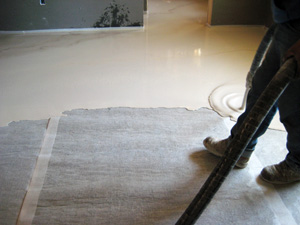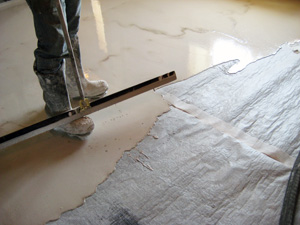KEENE BUILDING PRODUCTS has been an advocate of controlling moisture in sound mat/gypsum concrete applications since 2004. We changed the way the industry handles the large amount of moisture added to new construction projects through the placement of gypsum concrete when we developed the “MC” fabric for QUIET QURL. This new approach to the separation fabric acknowledged that when placing gypsum concrete about 7 gallons of water are added to a structure for every 33 square feet of floor space. In a typical one thousand square foot unit, that means 212 gallons of water are poured on the subfloor.
The moisture load of that much water is quite high and the traditional needle punched fabric used to suspend the gypsum concrete were originally designed to “filter” soil rather than suspend water. Needle punch, non-woven fabrics are designed to allow moisture to pass through while suspending particles. A typical needle punch fabric is evaluated with an AOS, or sieve size acknowledging that a certain size particle passes through the fabric and is screened. In fact, when placing gypsum concrete, contractors would notice an accelerated drying time since the gypsum was allowed to leak moisture from the bottom of the slab. Additionally, some contractors experienced an absorption of water with hydrophilic polymers used in the “entangled net” core. Nylon polymers can expand 3% or more since they are hydrophilic (moisture absorptive). Nylon expansion means that the joints may bulge and cause cracking on the seams. Polypropylene polymers do not have this characteristic since they are completely unaffected by water. The idea of a moisture control fabric is even more important to a nylon core, entangled net sound mat.
Other sound mats actually incorporated poly sheets that were like a slip-sheet for the gypsum concrete and sometimes caused cracking issues since the bottom side allowed no drying. Additionally, adding a vapor barrier to the floor/ceiling assembly is also not a constructive design. Vapor barriers may trap moisture in the cavity space causing long-term issues and designing a floor/ceiling that has the ability to breathe is a good idea if possible.
KEENE selected what is referred to in the industry as a point bonded sheet. Point bonded sheets are made from chopped fibers rather than longer “continuous” fibers. Point bonded fabrics used heated, knobby rollers to press the filaments together and create a monolithic surface which suspends the moisture laden gypsum without allowing much more than moisture vapor to pass through. It has a dense surface that cannot be used or screening particles and can hold a minor head of moisture. This point bonded fabric turned out to be the perfect “MC” or moisture control material for the application.

When specifying products for sound mat consider this moisture control as an added enhancement. Not only is it better but it additionally isn’t a cost add.
Additionally, all that moisture can wick into the gypsum wallboard. Proper placement procedures REQUIRE a substantial drying potential in each unit. That means ventilation through open windows. Close up a room and the potential for mold is significant not to mention the gypsum won’t get to full strength in a normal amount of time. Every room with QUIET QURL has perimeter isolation on the walls. This 4.0” strip separates the gypsum floor from the wall to control flanking noise but additionally separates the moisture-laden gypsum from coming in contact with paper-faced wallboard. Without the perimeter isolation, such as in carpeted areas, the gypsum is in direct contact with walls. That is a potential for moisture problems. Consider using perimeter isolation in all wall areas to minimize this.
Sounds good, doesn’t it!
